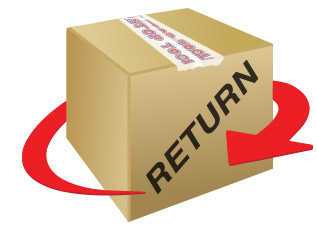A Universal Challenge for Drop Shippers
Drop shippers in countries around the world often have to deal with issues in customer orders and especially returns. While every drop shipper wants to have a great deal of orders, managing all of them in an efficient and cost-effective way can be a difficult task. The same goes for managing customer returns, although this can be even more problematic due to the unique nature of the drop shipping process. More specifically, the fact that the product must be returned to the manufacturer or wholesaler while the drop shipper refunds the customer themselves and waits for their own refund is a real issue. In fact, some people choose not to enter the industry for this very reason. However, both returns and orders themselves can be managed properly with the right processes. This article will provide a guide to these procedures and how it affects Drop Shipping in Australia.
Managing Orders: Step 1
When a customer purchases a product from a drop shipper, the drop shipper must communicate this information to the supplier, who then ships to the customer. Obviously, this is the defining characteristic of drop shipping. What might not be so obvious, however, is the way this must be managed.
It is important that the drop shipper view this process as an order exchange. That is, it’s a two way street. Data is sent from the retailer to the supplier, of course, but also from the supplier to the retailer. The supplier’s information comes before any information from the retailer, which may surprise those who are not veterans of the business. This information is in the form of catalogs and inventory. Catalogs show the products that the supplier can manufacture, and inventory refers to the products that the supplier has already made. A smart drop shipper will have begun to manage their orders before they happen by painstakingly reading the info from the supplier.
Managing Orders: Step 2
Once the order is placed by the customer, the next part of the order management process begins. The retailer sends the order information to the supplier, and then the supplier sends a confirmation message and a shipping notification to the retailer. This may sound simple, but as with nearly everything in the order management process, it is more difficult than it appears at first glance. This is especially true for the part of the process where the retailer sends the supplier the pertinent information. There are many different pieces of information that must be correct, or the order may not be filled correctly.
Managing Orders: Step 2: Info the Retailer Must Send the Supplier
There are roughly 20 pieces of information that should be sent to the supplier, and they should be formatted in the industry standard way. They are as follows:
POS Number: The number that the retailer’s system gives to the particular order.
Line Item SKU: The supplier’s designation for the particular item being ordered.
Line Item Title: The name of the item.
Line Item Quantity: The amount of the item being ordered.
Line Item Expected Cost (Optional): The amount the retailer expects to pay for the item.
Line Item Consumer Price (Optional): The amount that the customer has paid the retailer.
Ship Attention: The title of the customer receiving the shipment (Dr., Mr., Mrs.)
Ship First Name: The first name of the customer.
Ship Last Name: The last name of the customer.
Ship Company (Optional): The name of the customer’s company, if they have one.
Ship Address 1: The first line of the customer’s address.
Ship Address 2: The second line of the customer’s address.
Ship City: The customer’s city.
Ship Region: The region (usually state or province) that the item is being shipped to.
Ship Postal: The customer’s postal code (for countries that have postal codes).
Ship Country: The country that the customer lives in.
Ship Phone (Optional): The customer’s phone number.
Ship Email: The customer’s email. This is not really optional, as email is usually the
Ship Carrier: The name of the shipping service that will be used.
Ship Method: Air, Truck, etc.
Signature Required Flag: Very important! This determines whether a signature is required when the item is delivered.
Ship Instructions: Special instructions regarding the shipping of the item.
While this may seem like quite a lot, there are many commercially available software programs that will take care of this for you. However, it is important that you know what information needs to be transmitted so that you can set up this software.
The Drop Shipping Order Process as Compared to Traditional Order Processing
Traditional order processing involves two separate orders. The retailer orders the item from the supplier, and the customer orders the item from the retailer. Traditionally, the retailer’s order from the supplier happens first, when the retailer is stocking up on inventory. The customer’s order happens second. Obviously, the main conceit of drop shipping is that the customer’s order happens first.
When a drop-shipped order is placed by the customer, the retailer transfers the order to the supplier, and it becomes a purchase order at that point. All of this is basic information about drop shipping, however it is important to reiterate this information to make the point that nearly all order processing programs are set up in a way diametrically opposed to drop shipping practices. While it is easy for the drop shipper themselves to find software made specifically for them, the supplier may not have such a program. It is important to keep this in mind as a drop shipper for those times that a supplier has difficulty fulfilling an order, as getting upset with them may damage the relationship irreparably.
Automation in the Drop Shipping Order Process
Understandably, many drop shippers want to automate the order management process. This would save them time, and time is money when running a business. However, the unique process of drop shipping means that many issues can come up during the processing of an order.
Also, an automated order processing system doesn’t allow you to have the same relationship with your suppliers as doing your orders manually will. In the increasingly crowded modern drop shipping industry, this will allow you to stand out from the many other drop shippers the supplier is dealing with. The supplier may work with you by giving you a discount on their products, or by shipping your orders before everyone else’s. This may seem like an ethical gray area, but it is a reality of the business and a valid reason to process orders manually.
If you decide you want to automate, there are several things that need to be addressed. Common problems with automated systems include handling orders that can only be partially fulfilled by the supplier, backorders, and of course cancellations. With a manual order process, these issues will get taken care of as they appear. With an automated process, however, these issues may not be dealt with properly. Even worse, they might not come to the drop shipper’s attention until it is too late. If this happens, both the supplier and the customer may get quite upset.
A good idea in theory is to have an automated process handle orders were everything goes smoothly, and to handle other orders manually. However, this is difficult to actually implement. It is hard to find a software system that can do this accurately, and it can be trickier than you might expect to identify orders that need your attention. If you’re spending a lot of time doing this, of course, you lose the benefit of automating in the first place. If you can figure out how to mix automation and manual processing, you’ve hit the sweet spot in the drop shipping order processing dynamic.
Managing Orders in Reverse: Handling Returns
As previously mentioned, returns are more complicated for drop shipping businesses than they are for other ecommerce businesses, and certainly for brick and mortar businesses. This is exacerbated by the fact that ecommerce orders have exceptionally high return rates, sometimes approaching 25%. Obviously, you need to figure out an efficient return handling system. Of course, this is easier said than done. As with order processing, there is a list of pieces of information that needs to be coordinated in an industry-standard fashion. This list is as follows:
POS Number: The order identifier.
RMA Number: The return identifier.
Order Return Reason: The customer’s specified reason for returning the item.
Line Item Number: The supplier’s identifier for the item.
Line Item Return Reason: The retailer’s reason for returning the item to the supplier. May be different than the reason the customer gave.
Line Item Quantity: The quantity that the retailer is shipping to the supplier.
Line Item Condition: The condition of the item.
Line Item Expected Credit: The credit the retailer expects to receive from the supplier.
Note (Optional): Any additional information that the retailer wants to communicate to the supplier.
Needs Special Handling: Yes/No option to indicate if the item is fragile or not.
Return Attention: The contact at the supplier who is receiving the item.
Return Company: The name of the supplier’s company.
Return Address 1: The first line of the company’s address.
Return Address 2: The second line of the company’s address.
Return City: The city the company is located in.
Return Region: The region (often state or province) that the item is being returned to.
Return Postal Code (for countries that have postal codes): The postal code of the supplier.
Return Country: The two character ISO code for the country that the item is being shipped back to.
Return Phone (Optional): The supplier’s phone number. This is optional because email is the industry standard for communication and the supplier may be hard for an Australian to understand over the phone.
Return Email: Email of the supplier’s merchant services contact. Absolutely for reasons listed above.
Ship Carrier: The name of the company that is handling the shipping.
Ship Method: The way the item is being shipped (air, truck, etc.).
Return Tracking Number: The tracking number given to the shipment by the carrier.
Return Ship Cost: May or may not be paid by supplier (probably not).
Return Ship Date: The date the shipment actually left the retailer’s premises.
Return Ship Carrier: The company handling the return (may be different than the company that shipped the order to the customer).
Return Ship Method: The way that the item is being shipped (air, truck, etc.).
Consider the Supplier
As mentioned before in this article, the importance of a good relationship with your supplier cannot be overstated. The returns process should be discussed and agreed upon with your supplier before you actually start taking orders for their products. This way, there is a minimum of conflict when returns inevitably start coming in.
Generally, the first thing that you want to discuss is which location you’ll be sending your returns to. You may be able to have the customer send the return directly to the supplier. If not, you’ll have to figure out a way that you can receive the return yourself. This can be a big problem if you don’t have a physical presence. Also, you would then have to undertake the cost of shipping the item from your premises to the retailer.
The next thing you need to discuss are restocking fees. Most, if not all suppliers will have restocking fees of various amounts. Some suppliers are starting to do away with these fees, but this is certainly not yet widespread in the industry.
The last thing you need to discuss with your supplier in regards to processing returns is the overall return policy. You need to have this hammered out before you start selling, as it is something that you should communicate to your customer in the item listing. This policy will involve the supplier, as it must include any restocking fees that the customer is charged, the length of the window in which returns are accepted, and what causes are acceptable for returns. Hammering all of this out before any such situation actually happens is a good idea for both parties.
Preventing Returns in the First Place
To prevent returns, you must understand why customers return the items in the first place. The two most common reasons that customers return items are the product being the wrong size or the wrong item and the product not matching the description as listed. There isn’t anything that you can do about the customer ordering the wrong product, but you can try to prevent returns due to inaccurate or incomplete descriptions.
Customers want to know exactly what they’re purchasing without doing a great deal of reading. Having several clear pictures is an excellent way to go about this. Also, it is important to format your product description in the most efficient way. Many successful retailers like to start with a paragraph of sales-oriented language, then include a bulleted list of the most important specifications of the product. This way, the potential customer is being persuaded to buy the item and informed at the same time.
Returns are a Fact of Life for Drop Shippers
Despite your best efforts, there will be some returns to deal with. This is inevitable, especially for drop shippers. However, it doesn’t have to be a big deal. If you follow the instructions in this article, you won’t have that many returns to deal with. More importantly, you’ll have a procedure established with your supplier so that things can be handled quickly and easily. If you can do these things successfully, you’ve minimized the biggest issue a drop shipper has to face.

 Enter Here For A Free Preview Of The Largest Global Drop Shipper Index On The Net
Enter Here For A Free Preview Of The Largest Global Drop Shipper Index On The Net











